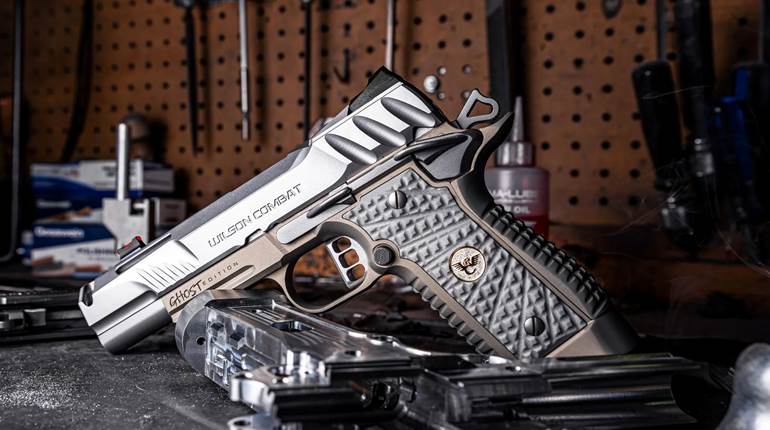
Just before our first wedding anniversary, my wife and I were rear-ended at high speed while making a right-hand turn. Our car was totaled and my wife suffered serious soft tissue damage to her neck and shoulder. Although she has healed over the years (the pain has never completely left her), it was a long time before she could participate in any shooting sports, let alone fire guns with stiff levels of felt recoil.
I started researching low-recoil defensive options that she could use (if you've ever wondered why I write about this topic as often as I do, now you know). At the time, Ruger was still making the now discontinued PC9 Police Carbine chambered in 9 mm. If not for the magazine well designed to accept Ruger P series pistol magazines, the blowback operated PC9 could be mistaken for a 10/22. It was lightweight, compact and easy to operate. I thought my wife would be able to manage the recoil at the practice range so that it could be kept on hand as a home-defense gun. The carbine had the added benifit of using the same magazines as a Ruger 9 mm pistol we owned at the time, making for an ideal home-defense pairing.
I strolled into a local gun shop and asked the college kid behind the counter to hand me a PC9 carbine off the rack for closer inspection. His face took on a subtle, but noticeable, look of distain. As if I had asked an English butler to pass me a dead mouse, he slowly reached for the rifle and with forced professionalism dropped it into my hands.

I explained why I was interested in this particular model. I was looking for a low-recoil defensive option for my wife to use. In a perfect dead-pan voice he said, “Yes, and when the ammunition runs out it will make an excellent club.” In other words, after 15 rounds of “wimpy” 9 mm hollow points fired through a 16" barrel harmlessly bounced off the home invader, like so much confetti, my poor wife would be forced to swing for the bleachers.
This gun store conversation took place in the late 1990s when the 9 mm and all of its platforms were still wrestling with the reputation of being weak defensive options. It's a bias that's stuck to 9 mms of all sizes like glue, even the carbines. That is, until the last few years. Defensive 9 mm pistols of all shapes and sizes have moved to the center of the defensive limelight. And this year in particular, pistol-caliber carbines (PCC) chambered in 9 mm have enjoyed a surge in sales not seen before.
Here are eight reasons why 9 mm PCCs are a good choice for home defense as well as general shooting.
8. A Variety of Models to Choose From
Some types of firearms are only available in limited configurations which in turn can make it a challenge to find a good fit for some shooters. This is not the case with pistol-caliber carbines. The 9 mm PCC may be enjoying a new level of popularity today but it's been manufactured by several companies for quite some time. I still hear folks talk about how much they love their Marlin Camp 9 even though the gun has been out of production since 1999.
If you enjoy working with the AR-15 type carbines, several 9 mms are available from reputable manufacturers including the ATI Milsport, SIG Sauer MPX 9 and the Wilson Combat AR9. The 9 mm AR models tend to come in two varieties, those with dedicated 9 mm only lower receivers and those that use standard .223/5.56 lowers fitted with magazine adapters.

Some models, including the Just Right Carbine and the caliber convertible TNW Firearms Aero Survival Rifle are built around proprietary actions that accept AR accessories. The receivers, barrels and controls are unique but the removable grips and six-position adjustable shoulder stocks can be swapped out for popular after-market AR-15 upgrades.

If the AR-15 is not your cup of tea, there are plenty of other designs to enjoy. The Hi-Point Firearms carbine line-up is one of the least expensive with a surprising number of features for what you pay. The Beretta Cx4 Storm and Kriss USA Vector Gen II CRB are both in-house designs while the Chiappa Firearms M1-9 is a modern variation of the WWII-era M1 carbine. One of the more unusual options (if you can find one) is the Kel-Tec Sub 2000 which folds in half for easy storage.

7. Proven Designs
Many semi-automatic 9 mm PCC platforms use blowback-operated actions, which are among the simplest and most reliable designs available. The bolt assembly is held in place by its own weight and the recoil spring. The force of the cartridge case being pushed backwards by expanding gases cycles the bolt. That's all there is to it. There's little in the way of complex parts, gas tubes or pistons to worry about failing and the guns are often easier to clean and lubricate.

6. Pistol Magazine Compatibility
Just like the Ruger PC9 mentioned earlier, many of the modern PCC platforms feed from removable semi-automatic pistol magazines. Right now many carbines have magazine wells and bolt assemblies designed to work with the common, easy to find and inexpensive Glock factory and aftermarket magazines. This is especially convenient if you already own, or plan to buy, a Glock pistol. Companies that make pistols as well as carbines, like Beretta, often build their carbines to accept the same magazines as their handguns.

5. Low Levels of Felt Recoil
I continue to be baffled by the notion that if a gun doesn't leave the owner battered and bruised at the end of a practice session it's not a legitimate home-defensive option. Guns don't need to hurt the operator in order to be effective. In fact, low recoil provides a couple of important tactical advantages. Any activity associated with pain can cause us to hesitate. In a fight for your life, when every moment counts, it's important to avoid any unnecessary hesitations that may cloud a defender’s judgment. Low recoil also aids in placing faster, more precise follow-up shots.

4. Cheap and Plentiful Practice Ammunition
Proper practice sessions held on a regular basis are the key to mastering a carbine's controls and to improved accuracy. The more rounds fired downrange per practice session the better. As of this writing, the only platforms I can find that are cheaper to run than the 9 mm are those chambered in .22 Long Rifle. The good news is that practice-grade 9 mm is more readily available than .22 (which is still experiencing shortages) and can be found in sporting goods and big-box stores around the country.
3. Top Notch Defense-Grade Ammunition
The 9 mm cartridge is not just popular in the United States, it's one of the most common calibers used around the world for military, law enforcement and civilian applications. Millions of dollars have gone into improving bullet designs and overall cartridge effectiveness. More +P loadings are available now than ever before. This improvement in cartridge performance combined with carbine magazine capacities ranging from 17 to 33 rounds provides a level of fire power not to be taken lightly, especially at home-defense distances.

2. Improved Ammunition Performance
Generally speaking, 9 mm pistols are constructed with barrels somewhere between 3" to 5" in length. Carbines, on the other hand, are usually fitted with 16" barrels. This increased length boosts the performance of the cartridge because of the longer powder burn time, which increases velocity, and additional rifling that improves bullet stability.
The degree to which performance improves when using a carbine depends on the load fired. But in some cases, especially with +P ammunition, the increase in downrange energy is impressive. The following table shows some of the 16" barrel performance results gleaned from carbine tests posted to this website along with the manufacturers’ listed pistol velocities for comparison.
The standard velocity loads shown here demonstrated a velocity increase of 101 to 238 f.p.s. resulting in bullet energy going up by 70 to 153 ft.-lbs. when fired through a 16" barrel. That's nothing to sneeze at. But it's the +P loads that seem to benefit the most from the longer barrel. Velocity jumped between 173 to 684 f.p.s. increasing bullet energy by 94 to 356 ft.-lbs.
1. Flexible and Fun To Shoot
Whenever possible, it makes sense to invest in firearms that can fill multiple roles instead of just one. The 9 mm PCCs fall into this category. These platforms are ideal for informal plinking, target shooting, home defense or riding along as a trunk gun. I've heard that a good sized part of what is driving the new interest in these guns are the new divisions in 3-Gun and other competitions that allow the use of 9 mm carbines. Imagine spending a day honing your shooting skills at a match, getting home, giving your carbine a quick cleaning and then staging the gun you know inside and out to defend your home in case of an emergency. That's about as flexible as a carbine gets.






































